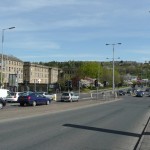If you thought your commute was bad, spare a thought for the drivers of Yorkshire.
The Leeds-Bradford area is the most congested in Britain, with drivers spending 86 hours a year stuck in jams.
Traffic in the conurbation increases journey times by an average of 28 per cent – and up to 63 per cent in the morning rush hour, a study has found.
Even Londoners have it easier, with drivers in the capital spending 74 hours a year in jams.
The traffic research, by satellite navigation firm TomTom, found Warsaw, in Poland, to be the most congested city in Europe. Leeds-Bradford came seventh and London eighth.
The research by satellite navigation firm TomTom looked at 31 cities across Europe with populations of more than 800,000.
The two Yorkshire areas have suffered a five per cent increase in congestion since last year, the biggest of anywhere in Europe.

Traffic Jams in Bradford
Drivers there face a delay of 36 minutes for every hour they drive in peak periods.
Third-worst in Britain was Birmingham where drivers spend an average 73 hours a year stuck in traffic jams.
Traffic in the West Midlands city is delayed by an average of 21 per cent because of congestion with delays of up to 28 minutes per hour during peak periods.
The worst days for congestion are Tuesday and Thursday in Leeds-Bradford and Birmingham while Mondays and Thursdays are worst in London.
The index is based on real travel times data captured by vehicles driving the entire European road network and compiled from five trillion data measurements.
The overall congestion level for all cities analysed in Europe is 24 percent – meaning peak journeys are a quarter slower than when traffic is flowing freely.
A spokesman for TomTom said: “It is amazing that Leeds-Bradford has overtaken London in our congestion ranking, with journeys in the area taking up to 63 per cent longer in the morning rush-hour.
“It shows that congestion is not limited to the capital, but is rapidly spreading around the UK’s regional cities.”
Harold Goddijn, chief executive officer of TomTom, said: “Over the years, with the help of our customers, we have built the largest and most accurate database of travel times in the world.
“When we combine this travel database with our detailed real-time traffic information and routing technology, we can not only pin point congestion, but can guide drivers away from congested areas onto faster routes.
“Even when only a percentage of drivers use a different and faster route, the available capacity on the entire road network increases, which benefits all drivers.”
Source: Daily Mail



